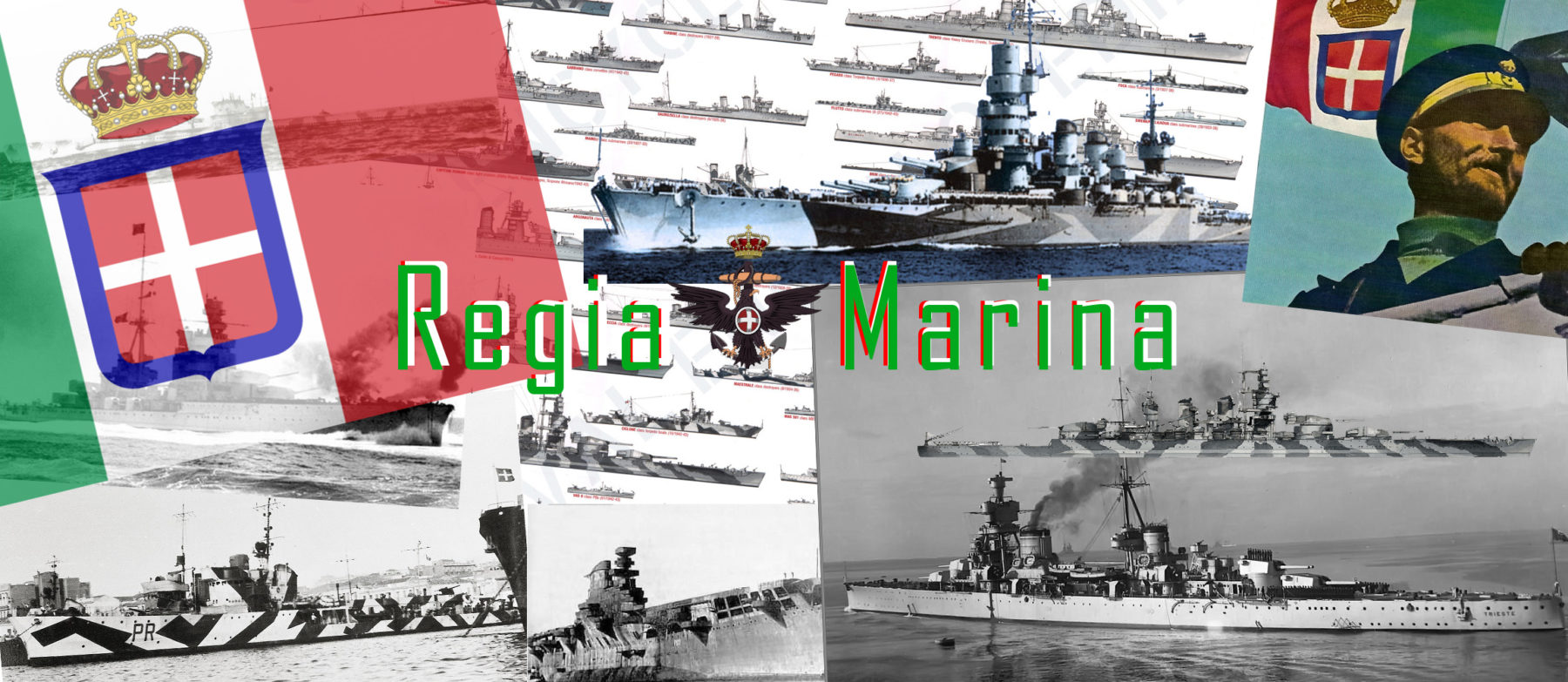
The Italian Navy (Regia Marina)
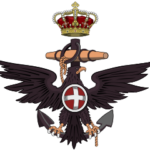 Interwar and WW2: Circa 560 ships in 1940, 5th rank:
Interwar and WW2: Circa 560 ships in 1940, 5th rank:
1 Aircraft Carrier (nearly completed), 7 battleships, 26 cruisers, 60 destroyers, 62 Torpedo Boats, 113 submersibles, 250+ misc vessels (Minelayer/sweepers, coastal defence, gunboats, seaplane carrier, MAS, VAS and other motor boats, ASW corvettes, etc.)
“Mare Nostrum”: This ancient motto known to the Greeks Byzantines and Turks was the embodiment of the navy dreamed by Mussolini. Il Duce indeed tried to restore in modern times the greatness of the Roman Empire, a perfect nationalistic theme setting an ambition for Italy in the XXth Century. Total control of the Mediterranean (the “roman lake”) was achieved at the beginning of the Roman Empire, and for Fascist Italy would have been the goal for a formidable colonial empire, raising Italy again to the rank of great power. However, this strategic area was then locked by France and Great Britain for the sake of their respective Empires.

Caio Duilio 1941. Her camouflage was changed again in 1943
The former aligned about the same number of ships to Italy, but dispersed between several strategic bases, securing passage to the Suez Canal, which basically shut the eastern Mediterranean while Gibraltar blocked access to the Atlantic. The neutrality of Spain ensured its perennial nature. Malta was a strategic position, and the port of Valletta is a fundamental step for access to the Eastern Mediterranean and to Egypt.
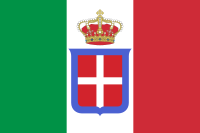
Articles Published and incoming
- Aircraft carrier Aquila
- Alberto di Giussano class cruisers
- Archimede class submarine (1933)
- Balilla class submarines (1927)
- Bandiera class submarine (1929)
- Brin class submarine (1938)
- Cadorna class cruisers (1931)
- Calvi class submarine (1935)
- Capitani Romani class Cruisers
- Cavour class battleships
- Curtatone class Destroyer (1922)
- Doria class battleships (1916)
- Duca d’Aosta class Cruisers (1934)
- Duca degli Abruzzi class cruisers
- Ettore Fieramosca (1929)
- Foca class submarine
- Folgore class destroyer (1931)
- Freccia class destroyer
- Gabbiano class Corvettes (1940)
- Generali class destroyers (1920)
- Giuseppe La Masa class destroyers (1918)
- Giuseppe Miraglia
- Glauco class submarine (1935)
- Goffredo Mameli class (1926)
- Leone class Destroyers (1921)
- Littorio class battleships
- Liuzzi class submarine (1939)
- Maestrale class Destroyer
- Marcello class submarine
- Marconi class Submersible
- Mirabello class scouts (1915)
- Motoscafi Di Turismo series (1940)
- Navigatori class Destroyer
- Palestro class destroyer
- Pietro Micca (1935)
- Pisani class submersibles (1928)
- Raimondo Montecuccoli class Cruisers (1934)
- Sauro class Destroyer
- Sella class Destroyer
- Trento class Cruisers (1927)
- Turbine class destroyer
- WW2 Italian battleships
- WW2 Italian Cruisers
- WW2 Italian Destroyers
- WW2 Italian Submarines
- WW2 Italian Torpedo Boats
- Zara class Cruisers (1931)
Costanzo Ciano class (1939)
Etna class
Leone class
Sella class
Sauro class
Turbine class
Navigatori class
Freccia class
Folgore class
Maestrale class
Oriani class
Soldati class
Cdt Medaglie d’Oro class
Albatros
Spica class
Pegaso class
Ciclone class
Ariete class
Balilla class
Archimede class
Glauco class
Foca class
Marcello class
Brin class
Liuzzi class
Marconi class
Cagni class
Romolo class
Mameli class
Pisani class
Bandiera class
Squalo class
Bragadin class
Settembrini class
Argo class
Argonauta class
Sirena class
Perla class
Adua class
Acciaio class
Flutto class
CM class
CC class
CA class
CB class
SLC/SSB class
ww2 Italian light MBs
MAS MBTs
MS class boats
VAS class ASW boats
MAT class
MTM class
MTL class
R Boats Minesweepers
Eritrea sloop (1936)
Diana sloop (1942)
Gabbaiano class Corvettes (1942)
Italian minelayers
Italian gunboats
France aligned the bulk of the Marine Nationale there to protect its possessions in North Africa and West Africa, a department like Algeria, its protectorates like Morocco, and guaranteed access through the Suez Canal to its Indochinese colonies, just as vital as India for the British Empire. Besides a main naval base in Toulon, other bases comprised Mers el-Kebir near Oran in Algeria, Bizerte, Rayak in Syria and Dakar on the west coast of Africa.
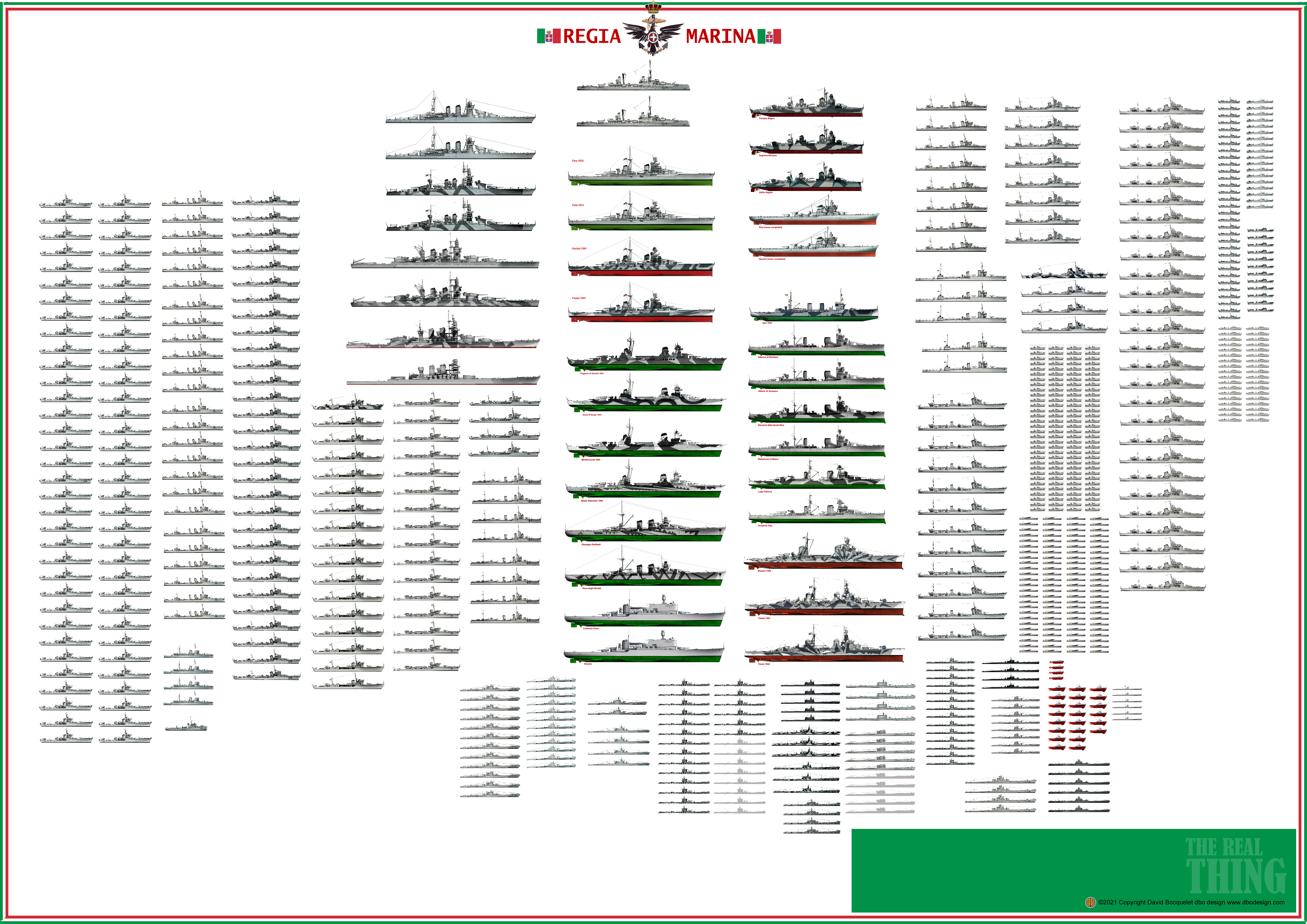
The totality of the Regia Marina in WW2 (work in progress)
Italy’s challenge
The Italian Navy was like Germany formerly a collection inherited from an ancient kaleidoscope of ten kingdoms, and since ww1 went a long way towards industrialization, not yet completed in 1940. The history of the Italian navy is also that of technological innovations Brought to the end of the 19th century by talented engineers like Duilio and Cuniberti, the latter now recognized as the pen genitor the new “breed” of monocaliber battleship better known as the Dreadnought in 1906. Of the three arms, Regia Marina was by far the most effective, and a powerful propaganda tool.
The ten-year moratorium imposed by Washington in 1922 stopped the construction of four fast battleships of the Caracciolo class. Construction of heavy units resumed in 1937, with the class Littorio (first true Italian “super-dreadnoughts”). The design paralleled a radical overhaul of ww1 dreadnoughts, Cesare and Duilio classes, which were brand new in 1940.
The Franco-Italian rivalry:
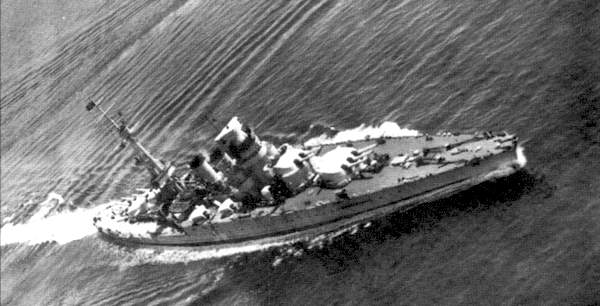
Based on tonnage (175,000 for each nation as allocated by Washington), the Franco-Italian rivalry in the Mediterranean quickly turned into a race almost on a unit-per-unit base. “Supermarina” was perceived very early as a threat by France to its ties to Africa and conversely the Marine Nationale became for Mussolini an obstacle to his cherished expansion, the first stage of which was Abyssinia in 1935, and then Libya.
Rivaly
To the two Courbet and three Bretagne class, The Italian only opposed four ww1 era dreadnoughts, the Cesare and Duilio. France seemed to have the advantage of numbers, but in reality the two units of the Courbet class had a questionable military value, older and with only cosmetic changes. The Provence class had a more thorough refit in the early 1930s, but this was not enough for 1940. As for fast battleships, to France’s Dunkirk class, Italy replied with her two Littorio. Then, with the Richelieu class was launched, the Roma class, enlarged sister-ships of the Littorio replied in turn, but too late. However neither Jean Bart (fr) nor Impero (It) were completed during the war.
Aircraft carriers:
France had definitely an advantage with Béarn (a converted battleship) against nothing comparable in Italy. The idea of an aircraft carrier in Italy was long brushed aside by Mussolini, speaking of Italy being itself a super-large aircraft carrier, which was arguably true due to the central position in the Mediterranean. The idea however resurfaced after the crushing defeat of Cape Matapan, where the Ministry of the Navy finally realized the importance of air support, later compounded by the breathtaking air raid on Tarento (the main inspirator for Pearl Harbour to the Japanese). The passenger ship Giuseppe Miraglia was converted to operate seaplanes in the 1920s, which answered to the French Commandant Teste, a far larger, purpose-built ship. while the conversion of two liners (modern, large and fast) was started, the Aquila and Sparviero, none was completed, while on the French side the two fast, purpose-built aircraft carriers of the French Joffre class of 1940 were never launched.

Italian heavy cruiser Trieste in Mar Grande, Taranto, early 1930s.
Cruisers:
The parallel resulting from this rivalry was even more evident in this particular area: To the two heavy cruisers Duquesne, Italy responded with the Trento. Then the Bolzano to oppose Algeria. Zara class corresponded to the four Suffren. The three light cruisers Duguay Trouin, Emile Bertin and Joan of Arc to the four Giussano, the first class Condottieri, and the two Cadorna of the second group. The six Galissonniere-class faced the Condotierri (2nd group), Montecuccoli and Abruzzi classes, for a total of six units.

3rd naval division: Trento, Trieste, Bolzano.
Destroyers:
As for the destroyers, “Supermarina” had a total of fifty-six units against fifty-eight for the French, compensating by new constructions in wartime, bringing this total to 66. However the French had a qualitative superiority in some areas. Italian units were well designed, inexpensive and fast, exported successfully, but remained small and relatively lightly armed, with limited autonomy. To “flotilla leader” squadrons, the 32 heavy French destroyers had equivalents only in the ww1 ships of the Leone and Mirabello classes (4 units). To the heavier Mogador, the Italians responded during the war with the “Capitani Romani”. Destroyers classes by chronology included the Sella, Sauro, Turbine, Navigatori, Freccia, Folgore, Maestrale, Oriani and Soldati, seven of which were completed during the conflict.

Soldati class destroyers
Torpedo Boats:
French torpedo boats were equal in value and quality to the Italians, but the Italians produced much more from 1936, with the Spica and Pegasus classes, which largely compensated for the French heavy destroyers (34 were also former reclassified destroyers built between 1916 and 1922). Other classes will follow during the war, for a total of thirty-two units. TBs were a must for short range operations in home waters, so they were largely seen as substitute destroyers for coastal defence. The 1,625 long tons Ciclone class of 1942 were considered rightly as escort destroyers. They were not supremely fast but had sonar and hydrophones plus improved ASW capabilities.
Miscellaneous:
To ensure colonial service, the sloop Erythrea was built. The yacht of the Admiralty, the frigate Diana, was also converted. To escort shipping and troops in Africa during the war, Italy also launched (lately) the construction of 47 corvettes of the “Gabbiano” class, a response to the British “Flower” well suited for the Mediterranean.
Submersibles:
As for the “submarines”, France has a homogeneous fleet of 81 units against 116 for the Italians. Both nations dispersed their production in numerous classes, counting sometimes only 2, 3 or 4 boats ranging between oceanic and coastal types. The French aligned the submarine cruiser Surcouf, while three Roland morillot and eight Aurore in 1940 were in construction when the war broke out. The Italians in wartime built 14 Acciaio and 10 Flutto (26 planned), underwater pocket submarine CMs (2 units), CC, CA (2) CB (22). Oceanic submarine base for operations was at La Pallice, Bordeaux in occupied France, to operate on the Atlantic.

Cagni class submarines

Porfidio class submarines, Acciaio class

Adua submarine

Squalo class submarine
The Regia Marina in June 1940 and in September 1943 (author unknown).
All about the Regia Marina
In this new section in redaction over this remaining year, i’ll do a far more detailed approach of the Regia Marina, with its command structure, doctrines, academia and design process, industry, sub-contractors, weaponry, sensors, ships specifics, and WW2 actions, with short biographics of prominent figures.
Appearance of Italian ships
Design and outlook
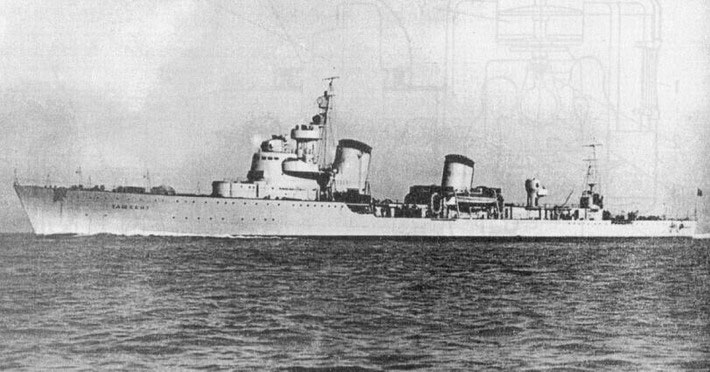
Tashkent, Italian-built destroyer leader for Russia, some authors flagged her as the “most handsome warship ever built”.
When the world “design” is call upon in naval literature, it does not have the same sense as for the general public. The design of a warship is not about aesthetic in general (that comes as an afterthought) but about functionality, architecture. However in the Italian case, perhaps because of the renaissance and art history, the secondary aspect was never far away, and was applied often as a “bonus”. It has been often said that Italian warships, especially cruisers, had a good balance, looked sleek and martial at the same time, thanks to their menacing towers, more than French ships, which often relied to low superstructures and tripod FCS instead. The littiorio for example looked well balanced and more pleasing to see than French Ships, more complicated and awkward, arguably.
Export successes met by Italian Yards also capitalized in part on this flair. A good example was the Soviet Navy’s experimental Tashkent, delivered without armament, which was given very streamlined superstructures with raken funnels and clipper bow to enhance her sense of speed, plus as she was destined to the black sea, she was painted in blue. Soon she earned the moniker “blue beauty”. Her career was less stellar and the Soviet Navy later planned ships inspired by her but far less aesthetic.
In fact Italian design left a clear imprint on the Soviet Navy, due to special relations developed in the interwar, which also impacted battleship, cruiser, destroyer, and submarine construction, down to fast motor boats. For modellers, this is an appreciated subject notably due to WW2 use and coloring.
Colors
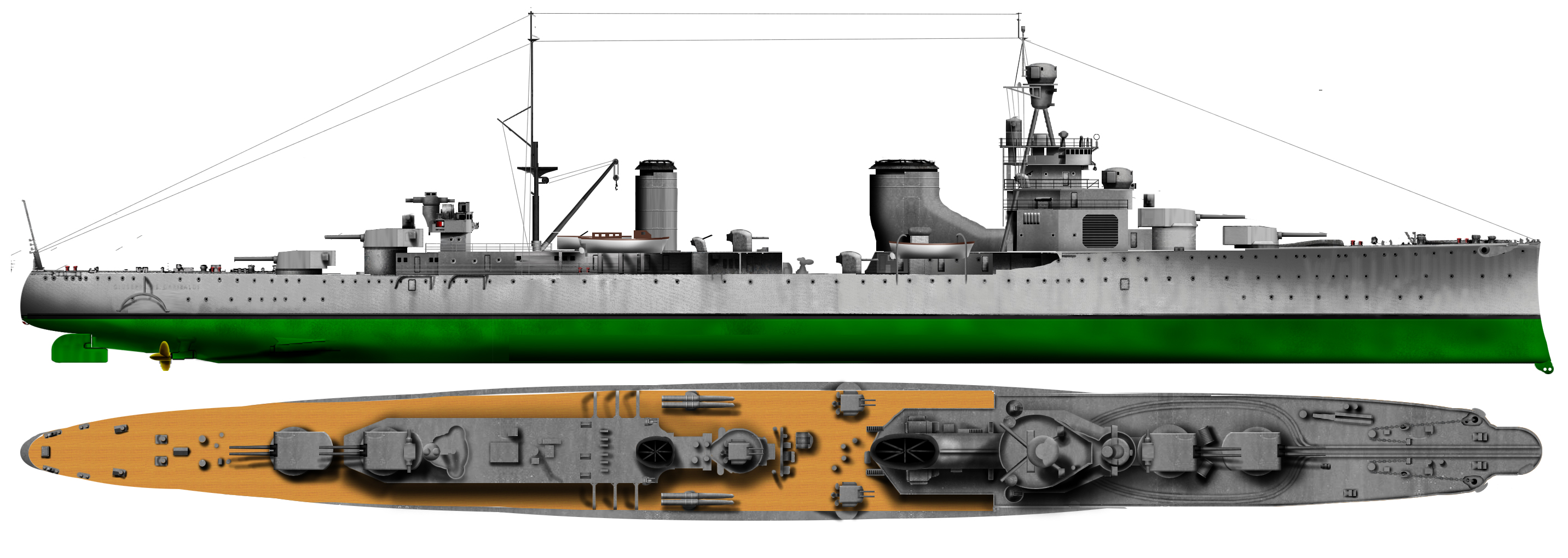
In the interwar, there was bo need of camouflaging ship, so the fleet kept its wartime colors, which was an overall ash grey color (Grigio Cenerino) for the superstructure or vertical surfaces above the waterline. Under it on large ships, hulls was painted dark green (Verde Scuro) according to the copper-base acetoareceniate blend to repel marine life. Smaller ships such as destroyers hulls was brick red (Rosso Mattone), also based on a repulsive primer. Decks were dark grey with some metallic traces (Grigio Ferro) but wooden decks remained unpainted, just varnish treated and cleaned often. The waterline was black as customary, but also the top part of the main mast and funnel caps, were black, given the effect of smoke.
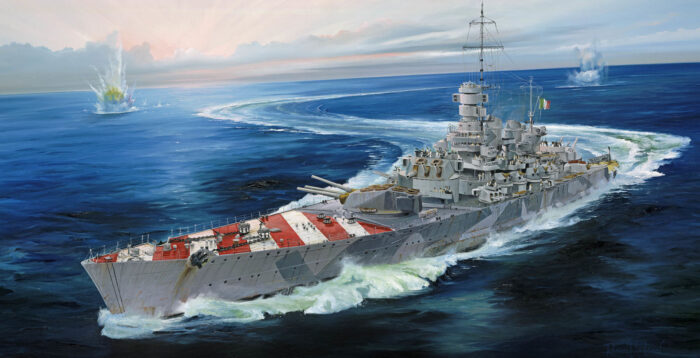
Hobby Boss artist impression of the Veneto, showing deck markings and camouflage in one go.
In WW2 two measures were taken:
-Vertical surfaces: Hulls and superstructures were camouflaged (from 1942 onwards) in the typical Mediterranean scheme largely adopted by navies at the time, and based on optical research work done in WW1. Given the nature of water, weather and light on this theater, it was composed of straight lines, broken lines, in dark grey over the prewar light grey scheme, and sometimes light azure blue. Wavy patterns were sometimes used, independently or in combination, but this was rarer. Litorrio was painted that way in 1942, as the Africano class light cruisers.

Muzio Attendolo in 1942, showing her peculiar camouflage, combining fake bow wave, straight lines and wavy patterns.
-Horizontal surfaces (decks): After an Italian aircraft made a “friendly bombing”, mistaken on own ship during the Battle of Calabria in July 1940, Supermarine ordered that identification marks were to be painted on all ships, large or small. The scheme retained was really visible indeed, consisting of alternating red and white stripes applied on the forecastle and quarterdeck of all the ships, large or small. Only submersibles did not have these for obvious reasons. Seaplanes had the same scheme repeated on their upper wings.
Older Italian Cruisers
San Giorgio coastal defense cruisers

The San Giorgio and San Marco were two armoured cruisers of 1908, which made the pride of the Italian Navy. Already in 1918, they were overwhelmed, but the Admiralty decided to keep one in use, the San Giorgio, to convert it into a coastal defense vessel, preferably assigned to the colonies of North Africa.
While her twin was disarmed and converted into a target ship, the San Giorgio was brought to the arsenal of La Spezia in 1937 for major redesign work, which largely changed its appearance.
Its engine was modified, with 4 oil boilers instead of the original 8 coal, reduced masts and remodeled superstructures, while AA artillery, 8 x 10mm guns, and 7 double carriage were added. heavy machine guns Breda 13.2 mm. However, he kept his armor and his heavy parts, very effective despite their small reach and their poor pace.
In 1940, she was rearmed with a 100 mm twin turret and 6 additional dual AA, and used as a static AA defense battery in Tobruk. It was there that she was scuttled at the announcement of the impending capture of the city by British troops, on January 22, 1941.
Specifications
Displacement: 9,470 t. standard -11 500 t. Full Load
Dimensions: 145 m long, 18.90 m wide, 6.30 m draft
Machines: 2 propellers, 4 Yarrow boilers, 60,000 hp.
Top speed: 14 knots
Armour: Belt 250, Decks 30-60, turrets 250, blockhouse 300 mm
Armament: 4×254 (2×2), 8×152 (4×2), 8×100 (4×2), 14 x 13.2 AA, 2 x 533 mm TTs (SM)
Crew: 650
Taranto

The Tarento was the former German cruiser KMS Strassburg granted in 1920 as a war damage to the Italian government, along with Venezia and Brindisi (former Austro-Hungarian class Saida), and Ancona (formerly Garudenz), and Bari (ex.Pillau).
The Tarento was completely rebuilt in 1936-37, the front chimney was truncated in the second, 3-inch/40 AA guns replaced the original 88 mm models. Her superfiring 15 cm gun was moved amidships, and in 1926 moved back again, this time to clear space for a platform, holding a scout plane, a Macchi M.7 and later a CANT 25AR.
At the beginning of the war an AA artillery was added, four twin 20 mm Breda cannons mount. Tarento served as a colonial cruiser, but guarded territorial waters during the war. She was scuttled at La Spezia to avoid capture by the Germans during the 1943 surrender. They managed to get the ship back anyway, but repairs were underway when an allied raid sank the the Taranto in October. She was refloated, repaired, but sank again during another air raid, and left there. She would be refloated and scrapped after the war.
Specifications
Displacement: 9,440 t. standard -11 575 t. Full Load
Dimensions: 187 m long, 18.90 m wide, 6.80 m draft
Machinery: 2 propellers, 2 Parsons turbines, 8 Yarrow boilers, 100,000 hp.
Top speed: 34 knots
Armour: Belt 130, bridge 30-40, turrets 135, blockhouse 100 mm
Armament: 10 x 152 (2×2, 2×3), 8 x 100 (4×2), 8 x 37 AA, 8 x 13.2 AA, 6 x 533 mm TTs (2×3)
Crew 692
Colonial Cruiser Bari
(To come)
Etna class cruisers (Poject)

The Italan naval industry enjoyed many export successes in the interwar. Their ships were undoubtedly more aesthetic, sleek, streamlined and modern in appearance, but also cheaper. In addition to sales to many countries, designers collaborated with the USSR, Sweden, or Spain (Orlando yard). Two Italian cruisers were ordered by Siam (Thailand) in 1938. This was to be the Taksin class.
The keels were laid in August and September 1939 at CRDA Montfalcone, but with the war breaking out, construction slowed sharply due to the lack of manpower and equipment, before stopping in December 1941. In August 1942, the Italian government requisitioned both ships, renamed Etna and Vesuvio. Construction restarted, albeit still slowly, and the first was launched in May 1942 and the second in August 1941. Political will however was not enough to force to work faster with limited means and both ships were still not completed, around 60% when the armistice of September 1943 came out. Seized by the Germans, work restarted, but to no avail. Both uncompleted ships were scuttled in Trieste. They were interesting as cheap export cruisers but their weak armament made them undesirable in the Regia Marina, both under-armed and under-powered, with the same output as a destroyer and badly protected with perhaps only AA defense as a more valuable asset.
Specifications
Displacement: 5,900 standard tons
Dimensions: 153.80 x 14.47 x 5.95 m
Powerplant: 2 Parsons turbines, 3 boilers, 40,000 hp, 28 knots.
Armor: Belt 60 mm, decks from 20 to 35mm
Armament: 6x 135mm/45 M38 (3×2), 10x 65mm/64, 20x 20mm/65 (10×2)
Miscellaneous ships
The Italians firmly believed in “naval dust” with the famous MAS, MTSM and MTSMA, MS and VAS patrollers which did wonders against the Austro-Hungarians in ww1, and tried in wartime some daring experiences with “Maiales” and “pigs”/SLCs, human torpedoes, and SSBs, MATs and MTMs, explosive MTRs. These cheap units were built in the hundreds and performed well in a few occasions.Older ships
The old cruiser San Giorgio (1908) revised in 1937 as a coastal defense ship, was extant as well as war reparation German ships (1918) relegated to the Colonies such as Taranto and Bari, Torpedo boats (ex-destroyers reclassified from the great war) of the Pilo class, Sirtori, La Masa, Palestro, Generali and Curtatone class, and single Audace and Insidioso units. A total of 34 ships, plus six H-class submarines (1917), three old battleships, three former Austrian minesweeper of the Albona class, Ostia and Fasana, and over 43 DR-class minesweepers also from WW1.
Wartime shipbuilding
During the conflict, Italy started an aircraft carrier, two cruisers, several “super-destroyers”, standard destroyers, torpedo boats and a large number of submarines, midget subs and crafts.
The sixth group of Condottieri included the Ciano and Venezia, launched in June, but whose construction was suspended in 1940. 12 light cruisers of the Capitani romani class were also started, 8 launched, but only four entered service. These were large “super-destroyers”.
The Etna class, initially ordered by Siam were requisitioned but never completed.
68 torpedo boats, 16 of the class Ciclone and 52 Ariete, were started but few were completed and entered service in 1943.

Procione torpedo boat, Pegaso class (1937) – Giorgio Parodi coll.
Destroyers of the class Commandante Medaglie d’Oro, very modern ships comparable to the American Fletcher or Gearing comprised 20 units, none of which was completed. Some destroyers of the second group of Soldati class were completed after the capitulation and served under German colors. Finally, the numerous Gabbiano class corvettes arrived too late in the war (1943) to effectively fight British submarines but they claimed the HMS Thunderbolt, HMS Sahib, and HMS Saracen.

Artigliere, Soldati class destroyer
Captured ships
For a short time, the French cruiser Jean de Vienne and La Galissonnière, sunk in Toulon, but salvaged and repaired were temporarily assigned to the Italian navy before the armistice, as FR11 and 12. They were never restored into operational service and were sunk by an Allied attack. In the same way, Toulon still had 11 destroyers of several classes, but only two were salvaged and repaired, entering active service as the FR21 (Lion) and FR32 (Scirocco) plus three Melpomène Class torpedo boats as the FR41 , 42 and 43. In addition, 9 submarines captured in Bizerte in 1942 by the Afrika Korps were transferred to Italy. The Yugoslav navy also captured in 1941 procured to Italy the powerful destroyers Dubrovnik, Ljubljana and Belgrade (renamed Premuda, Sebenico and Ljubljana) as well as six torpedo boats, two submarines, six minesweepers and a small gunboat.

colorized photo of battleship Duilio
Tonnage in 1939:
-4 Battleships
-19 Cruisers
-56 Destroyers
-70 Torpedo Boats*
-122 Submarines
-73 MAS
-75 Miscellaneous
*Including 34 old reclassed destroyers in 1939.
Additional units (entered in service between June 1940 and September 1943):
-3 battleships
-4 cruisers
-7 Destroyers
-50 Submarines
-47 Corvettes
-420 MTBs and misc.

Super-destroyer Scipione Africano – regiamarinaitaliana.forumgratis.org
“Supermarina” in operations
Mussolini funded great hopes for his fleet, justified by a real, objective offensive potential, especially after the defeat of France the the fate of her fleet, immobilized captured or destroyed. This event placed the entire Italian Navy face to the Royal Navy in this area. It should have been and interesting match for the best navy on the world. This became a three-years long affair.
The Navy had identified problems like sometimes too prudent admirals, politic meddling into naval affairs, industrial shortcomings, or not always well coordinated naval aviation, technological gap (radar, modern sonar). Surface actions were many, and certainly not a pushover for the Royal Navy: battles of Cape Spada, Cape Bon, Cape Passero, Skerki Bank, Tarigo convoy, Cigno convoy, Campobasso convoy, Duisburg convoys, Operation Harpoon, and others for cruisers and destroyers and battleships battles like Punta Stilo, Capo Teulada, Operation Vigorous, the two battles of Sirte and Cape Matapan. The first battle of Sirte proved a clear-cut Italian Victory while the second battle was a Pyrrhic victory for the British.

Cruiser Zara firing
The weakness of AA artillery was also patent, the bulk of which comprised Breda 13mm mounts, not fir to catch fast, modern planes. However after 1940s many units would receive 20mm and 37mm mounts. The lack of adequate ASW means also weighted a lot in the losses by British submarines (T, S and O classes), which participated to the deliquescent naval supplies to the axis in Africa. However this was an heaven match as the Regia Marina inflicted the most massive lost to the British submarine force: Of 76 submarines lost by the Royal Navy in WWII, 37 were sunk by Italian forces, 24 by the Germans and 4 by the Japanese forces, and 11 by accidents, friendly fire, or unknown causes*.
Finally, despite their success in 1917-1918 against the Austro-Hungarian fleet, MAS had perhaps less success in operation, as context differed and British bases, well guarded proved often out of reach. However they did score some successes against the Malta convoys, especially in August 1942 with operation Pedestal. The cohort of small crafts, either manned torpedoes, charges or midget submarines did also achieved some success with the raids on Alexandria, Gibraltar (multiple times), Souda Bay and Algiers.

Vittorio Veneto firing at the battle of cape Spartivento
Mostly inconclusive battles
The famous Battle of Cape Matapan, was essentially a defeat, but most other engagement like Punta Stilo, Cape Spartivento, the two battle of Sirte were inconclusive and Operation Harpoon/Vigorous was a clear-cut Italian victory.
Operations such as the blockade of Malta or the second battle of Syrta were half-successes (or Pyrrhic victories) and the Luftwaffe contributed to these.

(Aquila) during conversion
Successes: Submersibles and special operations
The Luftwaffe had a limited presence in the Mediterranean but the construction of two aircraft carriers should have changed the situation on the Italian side. Italian submarines were also the most successful, engaged with the same tactics as the Germans in the Mediterranean and the Atlantic. Arguably the most successful Italian operation of the war (even honored by their enemy) are to be credited to special units such as “Flotilla 10” using explosive MAT and “Maiales”, human torpedoes, inflicting serious losses Like the cruiser York, the battleships Valiant and Queen Elizabeth.

MAS camouflaged in 1942
Armistice and consequences
The final sortie of the Italian Navy was played in September 1943, with the armistice. Regia Marina went to surrender to the allies, but the Luftwaffe waited for them, testing their Henschel flying bombs (the first antiship missiles) and sinking the capital ship Roma and destroyer Vivaldi. However most of the navy successfully made it to allied ports and did took part in 1944-45 operations, including succesful “special operations” by submarines on the German-occupied Italian coast.
There, attempts to repair and rebuild scuttled ships by Germany were generally unsuccessful. However, some units of the Kriegsmarine i this theater of operations used captured Italian ships, sometimes equipped with modern radars and AA artillery. Most were sunk or scuttled in 1944-1945, and a few joined the Italian Social Republic (SALO regime).
Finally, some Ex-Italians ex-German submarines carrying supplies and never returned were recovered by the Japanese and, in turn, sunk by the US Navy. After the war, surviving ships were distributed as compensation between France and the USSR. These ships were used until the 1970s, proof of their sturdiness. There was another, perhaps more trivial aspect about Italian ships that has to be noticed, they were arguably handsome. Built for USSR, the “blue beauty” was a famous black sea destroyer. Italian yards also largely participated in the design of Soviet destroyers and cruisers.
Sources
*https://www.naval-history.net/WW2aBritishLosses10tables.htm
regiamarina.net/
en.wikipedia.org/wiki/Regia_Marina
en.wikipedia.org/wiki/Battle_of_the_Mediterranean
navypedia.org/ships/italy/it_cm_amc2.htm
defensemedianetwork.com/stories/book-review-mussolinis-navy/
Conway’s all the world fighting ships 1906-1921 & 1921-1947

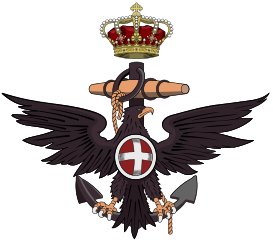

 Latest Facebook Entry -
Latest Facebook Entry -  X(Tweeter) Naval Encyclopedia's deck archive
X(Tweeter) Naval Encyclopedia's deck archive Instagram (@navalencyc)
Instagram (@navalencyc)





 French Navy
French Navy Royal Navy
Royal Navy Russian Navy
Russian Navy Armada Espanola
Armada Espanola Austrian Navy
Austrian Navy K.u.K. Kriegsmarine
K.u.K. Kriegsmarine Dansk Marine
Dansk Marine Nautiko Hellenon
Nautiko Hellenon Koninklije Marine 1870
Koninklije Marine 1870 Marinha do Brasil
Marinha do Brasil Osmanlı Donanması
Osmanlı Donanması Marina Do Peru
Marina Do Peru Marinha do Portugal
Marinha do Portugal Regia Marina 1870
Regia Marina 1870 Nihhon Kaigun 1870
Nihhon Kaigun 1870 Preußische Marine 1870
Preußische Marine 1870 Russkiy Flot 1870
Russkiy Flot 1870 Svenska marinen
Svenska marinen Søværnet
Søværnet Union Navy
Union Navy Confederate Navy
Confederate Navy Armada de Argentina
Armada de Argentina Imperial Chinese Navy
Imperial Chinese Navy Marinha do Portugal
Marinha do Portugal Mexico
Mexico Kaiserliche Marine
Kaiserliche Marine 1898 US Navy
1898 US Navy Sovietskiy Flot
Sovietskiy Flot Royal Canadian Navy
Royal Canadian Navy Royal Australian Navy
Royal Australian Navy RNZN Fleet
RNZN Fleet Chinese Navy 1937
Chinese Navy 1937 Kriegsmarine
Kriegsmarine Chilean Navy
Chilean Navy Danish Navy
Danish Navy Finnish Navy
Finnish Navy Hellenic Navy
Hellenic Navy Polish Navy
Polish Navy Romanian Navy
Romanian Navy Turkish Navy
Turkish Navy Royal Yugoslav Navy
Royal Yugoslav Navy Royal Thai Navy
Royal Thai Navy Minor Navies
Minor Navies Albania
Albania Austria
Austria Belgium
Belgium Columbia
Columbia Costa Rica
Costa Rica Cuba
Cuba Czechoslovakia
Czechoslovakia Dominican Republic
Dominican Republic Haiti
Haiti Hungary
Hungary Honduras
Honduras Estonia
Estonia Iceland
Iceland Eire
Eire Equador
Equador Iran
Iran Iraq
Iraq Latvia
Latvia Liberia
Liberia Lithuania
Lithuania Mandchukuo
Mandchukuo Morocco
Morocco Nicaragua
Nicaragua Persia
Persia San Salvador
San Salvador Sarawak
Sarawak Uruguay
Uruguay Venezuela
Venezuela Zanzibar
Zanzibar Warsaw Pact Navies
Warsaw Pact Navies Bulgaria
Bulgaria Hungary
Hungary

 Bundesmarine
Bundesmarine Dutch Navy
Dutch Navy Hellenic Navy
Hellenic Navy Marina Militare
Marina Militare Yugoslav Navy
Yugoslav Navy Chinese Navy
Chinese Navy Indian Navy
Indian Navy Indonesian Navy
Indonesian Navy JMSDF
JMSDF North Korean Navy
North Korean Navy Pakistani Navy
Pakistani Navy Philippines Navy
Philippines Navy ROKN
ROKN Rep. of Singapore Navy
Rep. of Singapore Navy Taiwanese Navy
Taiwanese Navy IDF Navy
IDF Navy Saudi Navy
Saudi Navy Royal New Zealand Navy
Royal New Zealand Navy Egyptian Navy
Egyptian Navy South African Navy
South African Navy






























 Ukrainian Navy
Ukrainian Navy dbodesign
dbodesign